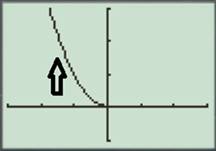
(a)
To plot: The graph of the parametric equations, the initial and terminal points and indicate the direction in which the curve is traced.
(a)
Answer to Problem 6E
The graph of the parametric equations with the direction is shown in figure (1), the initial point is
Explanation of Solution
Given information: The equations are
Calculation:
Use the following step to graph the parametric equations by graphing calculator.
Step 1: First press the “ON” button graphical calculator.
Step 2: Press the
Step 2: Press
Step 3: Press

Figure (1)
If
Therefore, the graph of the parametric equations with the direction is shown in figure (1), the initial point is
(b)
To find: The Cartesian equation and the portion of the graph of the Cartesian equation that is traced by the parameterized curve.
(b)
Answer to Problem 6E
The Cartesian equation is
Explanation of Solution
Given information: The equations are
Calculation:
Square both sides of the equation
Substitute
The above Cartesian form is an equation of parabola. From the graph shown in part (a), the left half of the graph of the Cartesian equation is traced by the parameterized curve.
Therefore, the Cartesian equation is
Chapter 1 Solutions
Calculus: Graphical, Numerical, Algebraic
Additional Math Textbook Solutions
Elementary Statistics (13th Edition)
University Calculus: Early Transcendentals (4th Edition)
Elementary Statistics: Picturing the World (7th Edition)
Algebra and Trigonometry (6th Edition)
A First Course in Probability (10th Edition)
- i need help pleasearrow_forward(#1) Consider the solid bounded below by z = x² and above by z = 4-y². If we were to project this solid down onto the xy-plane, you should be able to use algebra to determine the 2D region R in the xy-plane for the purposes of integration. Which ONE of these limite of integration would correctly describe R? (a) y: x24x: -22 - (b) y: 22 x: 04-y² (c) y: -√√4-x2. →√√4x²x: −2 → 2 (d) z: 24-y² y: -2 → 2 (e) None of the abovearrow_forwardX MindTap - Cenxxxx Answered: tat "X A 26308049 X 10 EKU-- SP 25: X E DNA Sequenc X b/ui/evo/index.html?elSBN=9780357038406&id=339416021&snapshotid=877369& GE MINDTAP , Limits, and the Derivative 40. Answer 5 4-5 t-10 5 f(x) = 2x - 4 if x ≤0 if x 0 10 ++ -4-3-2-1 f(x) = MacBook Pro Search or type URL 5 1234 x² +1 if x = 0 if x = 0 +arrow_forward
- MindTap - Cemy X Answered: tat x A 26308049 × 10 EKU--SP 25:11 × E DNA Sequence x H. pylori index.html?elSBN=9780357038406&id=339416021&snapshotid=877369& NDTAP and the Derivative 41. 42. Answer 12 Ay 5 + -10-5 5 10 -5- f(x) = x +5 if x ≤ 0 -x²+5 if x > 0 to -5 5. 5 f(x) = |x − 1| MacBook Pro AAarrow_forwardMind Tap - Cenxxx Answered: tat X A 26308049 × 10 EKU-- SP 25: X E DNA Sequence x H. pylor vo/index.html?elSBN=9780357038406&id=339416021&snapshotld=877369& MINDTAP its, and the Derivative 44. Answer 5 X -10-5 5 10 -5. f(x) = 2 + x +5 if x 0 3 4 f(x) = x² - 1 x+1 if x = -1 MacBook Pro G Search or type URL if x = -1 + AA aarrow_forwardCalculus lll May I please have an explanation of the multivariable chain rule in the example given? Thank youarrow_forward
- Mind Tap - Cenxxx Answered: tat X A 26308049 X 10 EKU-- SP 25:1 x E DNA Sequence x H. pyl /nb/ui/evo/index.html?elSBN 9780357038406&id=339416021&snapshotid=877369& ⭑ SAGE MINDTAP a ons, Limits, and the Derivative 吃 AA In Exercises 45, 46, 47, 48, 49, 50, 51, 52, 53, 54, 55, and 56, find the values of x for which each function is continuous. 45. f(x) = 2x²+x-1 Answer▾ 46. f(x) = x³- 2x²+x-1 47. f(x) 2 = x²+1 Answer 48. f(x) = 49. f(x) = Answer 50. f(x) = 51. f(x) = I 2x²+1 2 2x - 1 x+1 x-1 2x + 1 x²+x-2 Answer↓ 52. f(x)= = x-1 x2+2x-3 53. $ % MacBook Proarrow_forward37. lim f (x) and lim f (x), where x+0+ x 0 Answer -> 38. lim f (x) and lim f (x), where +0x x―0M 2x if x 0arrow_forward37. lim f (x) and lim f (x), where x+0+ x 0 Answer -> 38. lim f (x) and lim f (x), where +0x x―0M 2x if x 0arrow_forward
- Apply the Chain Rulearrow_forwardCalculus lll May I please have the solution for the following exercise? Thank youarrow_forward2z = el+cos(x+y) 24 = olt etz dy = 1 dt dz e²² + cos (+²+1++). 2++ (1+++cos C+²+1++) (+) dz 2+. etz 2t, + 2+⋅ cos (t² +++ 1) + t (1++1 dt + cos (+²+++1) 2. W= (yz) (yz) x x=e8++ 2 y= 3² + 3st, z=sent, hallar 2w 2w د 2u 2t 25 2t AX119 S Narrow_forward
 Calculus: Early TranscendentalsCalculusISBN:9781285741550Author:James StewartPublisher:Cengage Learning
Calculus: Early TranscendentalsCalculusISBN:9781285741550Author:James StewartPublisher:Cengage Learning Thomas' Calculus (14th Edition)CalculusISBN:9780134438986Author:Joel R. Hass, Christopher E. Heil, Maurice D. WeirPublisher:PEARSON
Thomas' Calculus (14th Edition)CalculusISBN:9780134438986Author:Joel R. Hass, Christopher E. Heil, Maurice D. WeirPublisher:PEARSON Calculus: Early Transcendentals (3rd Edition)CalculusISBN:9780134763644Author:William L. Briggs, Lyle Cochran, Bernard Gillett, Eric SchulzPublisher:PEARSON
Calculus: Early Transcendentals (3rd Edition)CalculusISBN:9780134763644Author:William L. Briggs, Lyle Cochran, Bernard Gillett, Eric SchulzPublisher:PEARSON Calculus: Early TranscendentalsCalculusISBN:9781319050740Author:Jon Rogawski, Colin Adams, Robert FranzosaPublisher:W. H. Freeman
Calculus: Early TranscendentalsCalculusISBN:9781319050740Author:Jon Rogawski, Colin Adams, Robert FranzosaPublisher:W. H. Freeman
 Calculus: Early Transcendental FunctionsCalculusISBN:9781337552516Author:Ron Larson, Bruce H. EdwardsPublisher:Cengage Learning
Calculus: Early Transcendental FunctionsCalculusISBN:9781337552516Author:Ron Larson, Bruce H. EdwardsPublisher:Cengage Learning





